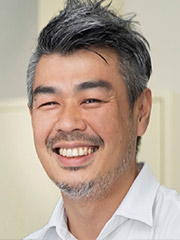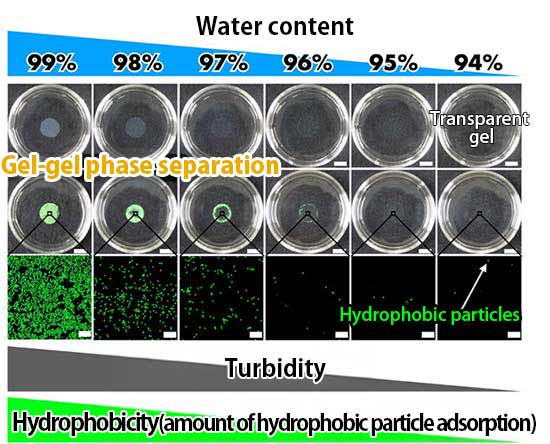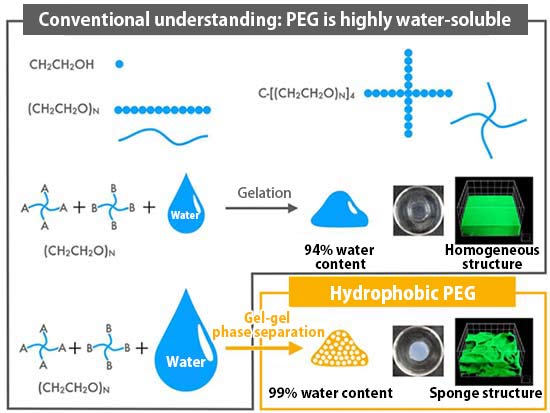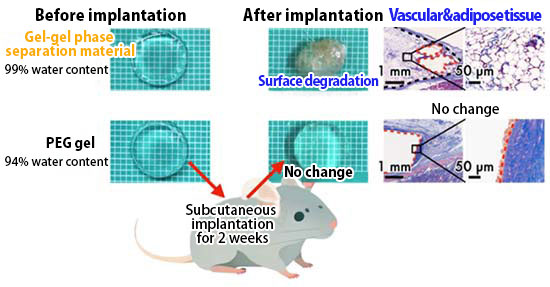Research Results
Innovative Scaffold Material That Regenerates Biological Tissues
Development of a Gel-Gel Phase Separation Material with 99% Water Content and Enhanced HydrophobicityFY2025

- SAKAI Takamasa (Professor, Graduate School of Engineering, The University of Tokyo)
- CREST
- Research Director (2019-2024), Nanomechanics area: Elucidation of Robust-Toughening Mechanism of Gels and Development of Artificial Tendon and Ligament
World's first discovery of gel-gel phase separation
A research group led by Professor Takamasa Sakai at the Graduate School of Engineering, The University of Tokyo made the world's first discovery of gel-gel phase separation, in whereby the water-soluble polymer*1 polyethylene glycol (PEG)*2 separates into the two distinct phases—a dense gel phase and dilute gel phase—within a PEG hydrogel characterized by high water retention. This process resulted in the formation of a fibrous mesh network of dense gel structures, approximately 100 micrometers in size, embedded within the dilute gel. Remarkably, despite its 99% water content, the PEG hydrogel exhibited pronounced hydrophobicity (Fig. 1).
PEG gels are widely employed in applications such as soft contact lenses, hemostatic agents, drug delivery systems, tissue engineering, and medical diagnostics. Although their physical properties have been extensively studied, no hydrophobic sponge-like PEG structures had been previously observed.
When the research group subcutaneously implanted the newly developed gel-gel phase separated PEG material into model animals, they observed that cells migrated into the fibrous mesh from surrounding tissues, subsequently forming adipose tissue that included blood vessels. This level of bioaffinity was not observed in conventional PEG gels; thus, the material holds potential as a scaffold for tissue regeneration, including applications in skin and vascular tissue repair.
*1 Water-soluble polymer
A large molecular compound characterized by solubility in water. Some examples of water-soluble polymers include plant-based gelatin, animal collagen, jelly, and polyethylene glycol (PEG).
*2 Polyethylene glycol (PEG)
A water-soluble synthetic polymer compound used in pharmaceuticals such as COVID-19 vaccines and industrial products.

Fig.1 When preparing gel, the more the water content is increased, the more the phase separation progresses, prompting the gel to exhibit turbidity and adsorb more hydrophobic particles.
Development of PEG gel serving as a scaffold for tissue regeneration
Research in tissue engineering, aimed at regenerating and repairing tissues and organs compromised by diseases, injuries, or aging is rapidly advancing. Effective tissue regeneration relies on scaffolds that facilitate cell adhesion and proliferation. Although biomaterials such as collagen and gelatin have been developed as scaffolds and offer good biocompatibility, including low immunogenicity and toxicity, they also present risks such as foreign body reaction*3 and infections-especially with animal-derived materials that may transmit viruses. Consequently, synthetic scaffold materials have been developed in parallel. However, synthetic materials often exhibit poor cell adhesion. While chemical modification*4 can enhance cell adhesion, increasing material complexity may lead to unpredictable biological responses, complicating their practical use.
Under these conditions, although PEG is an artificially synthesized substance known for its high biocompatibility due to low immunogenicity and toxicity, conventional PEG gels comprise a mesh structure on the order of 10 nanometers—significantly smaller than cells—resulting in poor cell adhesion. Consequently, PEG gels have historically been deemed unsuitable as scaffolds for tissue regeneration.
*3 Foreign body reaction
The body's recognition of substances that differ from its own and reaction to them. Examples include reactions to implanted medical devices and transplanted organs.
*4 Chemical modification
The process of changing the structure of a compound for a specific purpose. This is performed to, for example, improve the solubility and reactivity of substances.
Success in animal tissue regeneration with gel-gel phase separation materials
To elucidate this phenomenon, the research group d collaborated with microscopy expert Yasushi Okada, Team Leader of the Laboratory for Cell Polarity Regulation at the RIKEN Center for Biosystems Dynamics Research. The resulting micrographs vividly captured the gel-gel phase separation, aptly confirming the adage "a picture is worth a thousand words.".
The observed gel-gel phase separation not only induced hydrophobization of PEG gel but also facilitated the formation of a matrix with a characteristic mesh size of approximately 100 micrometers, enabling cell infiltration. Moreover, increasing the water content accentuated both phase separation and hydrophobicity, in other words, the more water a gel contains, the more hydrophobic the gel becomes (Fig. 2).
These findings indicate that the properties of PEG, traditionally predicted based solely on its chemical structure, can be significantly modified through the formation of a three-dimensional mesh network. While polymer properties have generally been attributed to chemical composition rather than molecular weight or network architecture, this discovery may herald a paradigm shift in polymer chemistry.
The research group subsequently fabricated a gel-gel phase separation material consisting of 99% water and 1% PEG, and conducted subcutaneous implantation experiments in model animals. These experiments demonstrated that cells migrated into the mesh structure, leading to the degradation of the material and the formation of adipose tissue with embedded blood vessels at the implantation site (Fig. 3).

Fig.2 PEG is inherently hydrophilic. For instance, ethanol CH2CH2OH, the PEG monomer (basic unit), single-chain PEG (CH2CH2O)N, and ranched PEG structure are all hydrophilic, regardless of the degree of polymerization N. Moreover, traditional PEG gels-which retains water within a three-dimensional mesh—have always been characterized by hydrophilicity. In contrast, this research successfully synthesized a hydrophobic PEG gel via gel-gel phase separation, a world-first achievement.

Fig.3 The conventional PEG gel exhibited no significant changes in either the gel or the surrounding PEG gel and a gel-gel phase separation material were subcutaneously implanted in mice for 2 weeks. The conventional PEG gel exhibited no significant changes in either the gel or the surrounding tissues, whereas the gel-gel phase separation material underwent degradation, resulting in the formation of blood vessels and adipose tissue at the site of decomposition.
Contribution to the development of novel polymer materials beyond tissue engineering
The research group believes that the findings of this study open up new avenues in tissue engineering. The developed gel-gel phase separation material has the potential to mitigate infection risks associated with biomaterials while addressing the low biocompatibility typically encountered in synthetic materials. Consequently, it holds promise for broad application as a safe and effective tissue regeneration scaffold—particularly in promoting subcutaneous tissue regeneration, which may benefit the treatment of chronic wounds and diabetic foot ulcers that severely impact patient quality of life and increase healthcare costs.
Furthermore, the relatively simple manufacturing process and regulatory procedures for these materials may expedite commercialization, and the underlying principles of gel-gel phase separation could be extended to other polymers, driving the development of innovative polymer materials.
